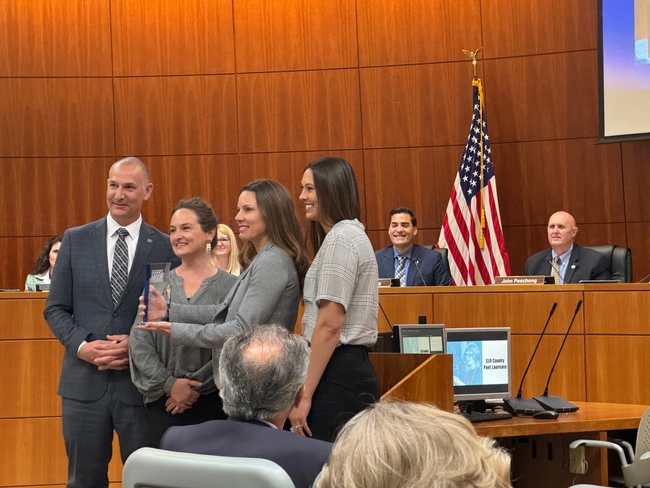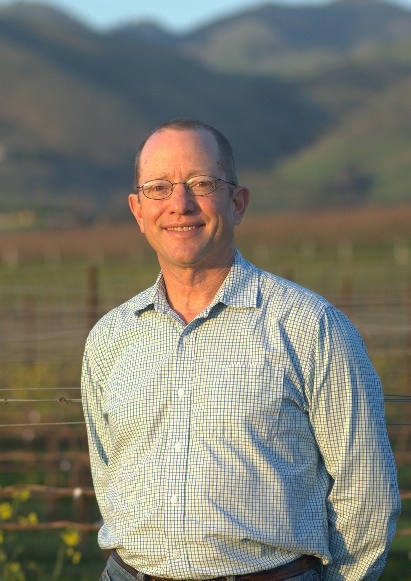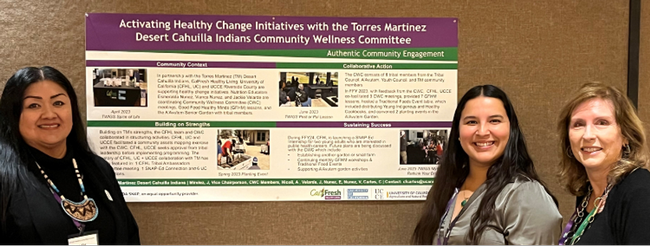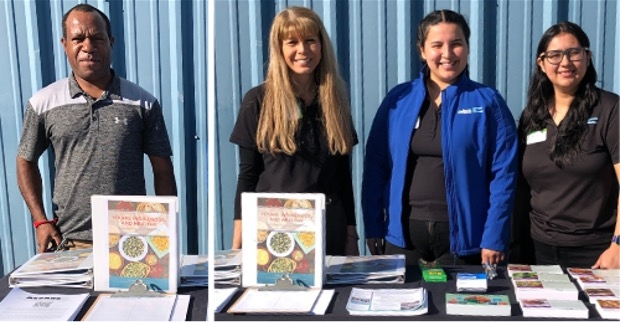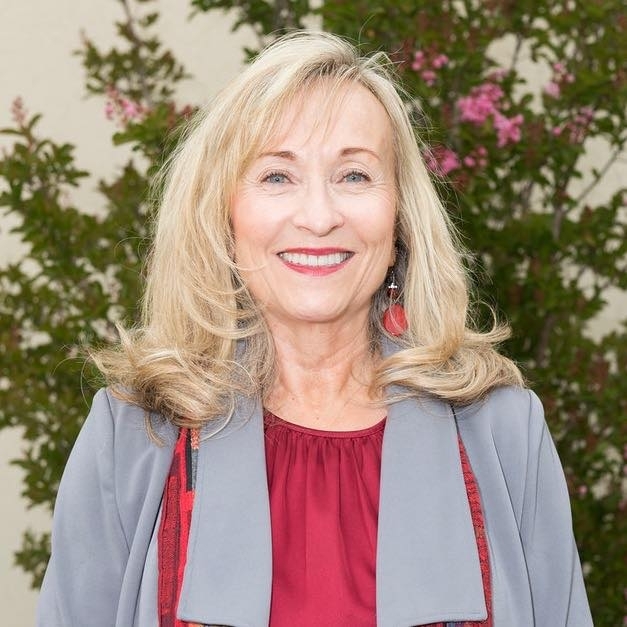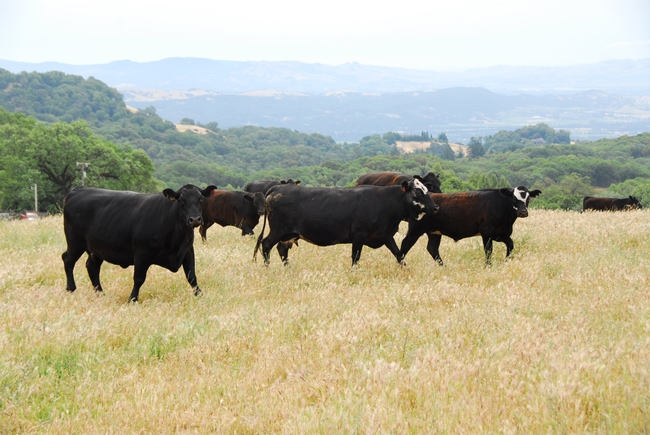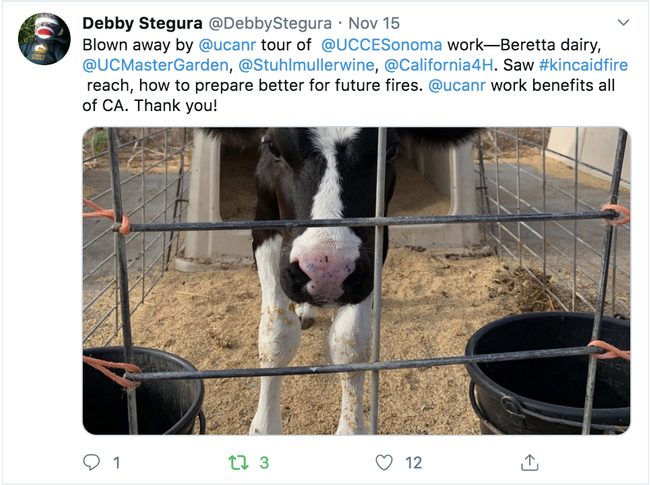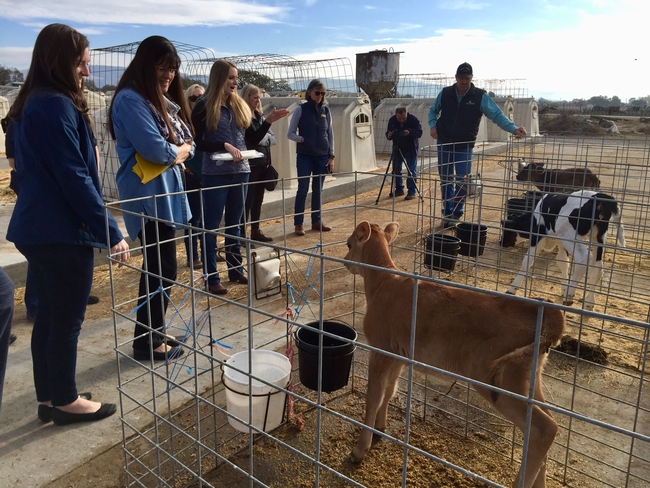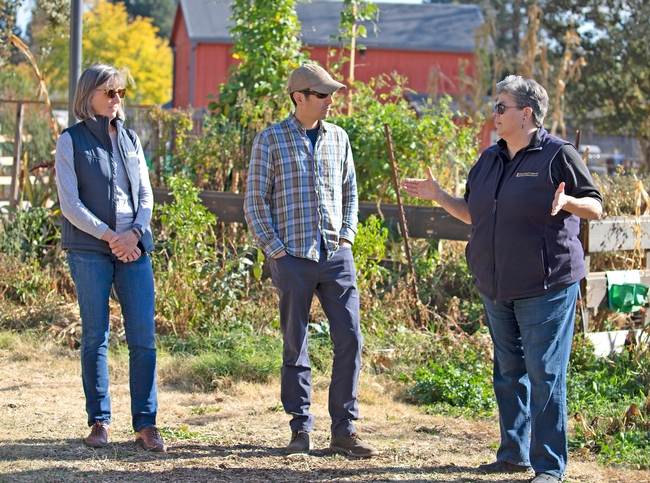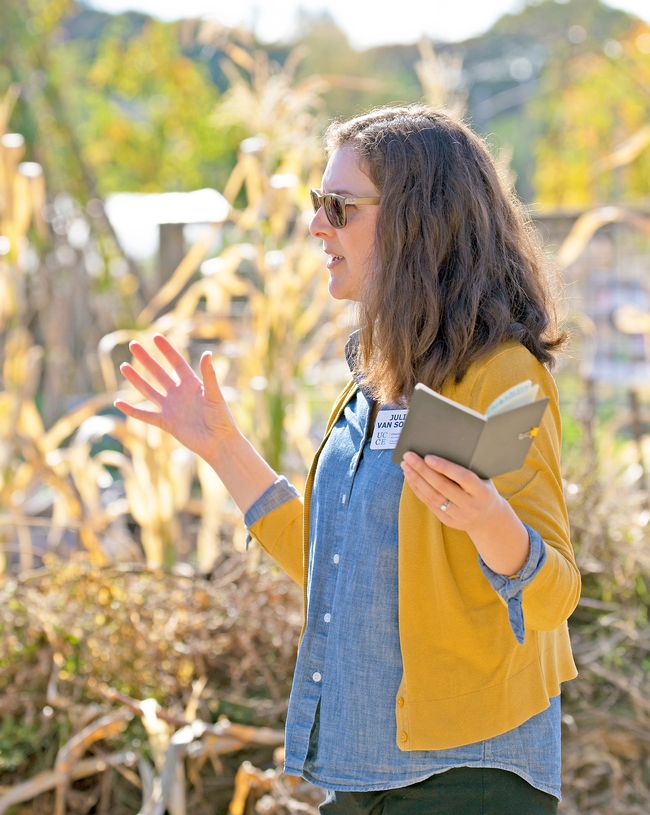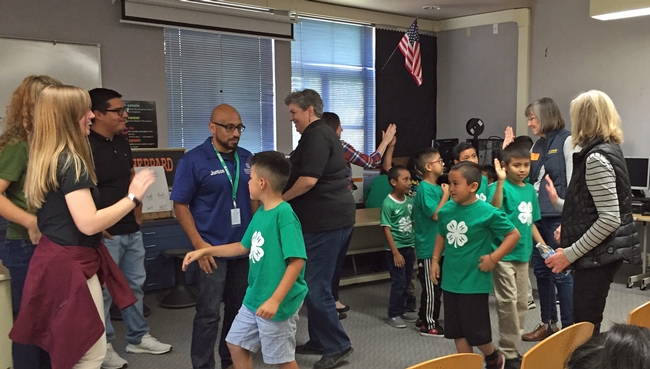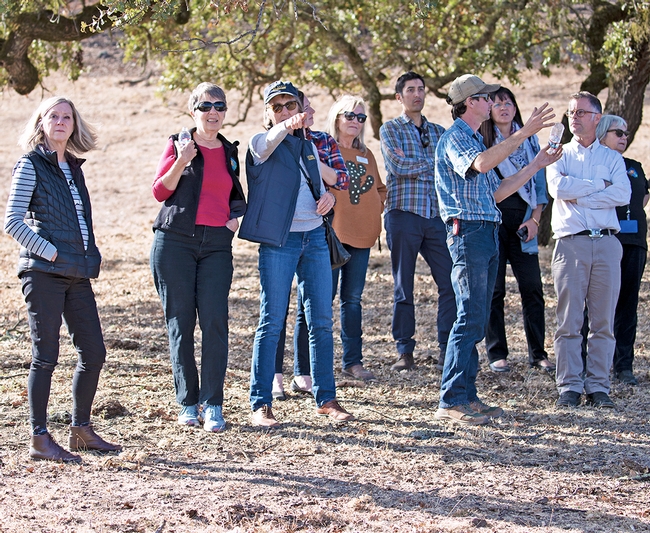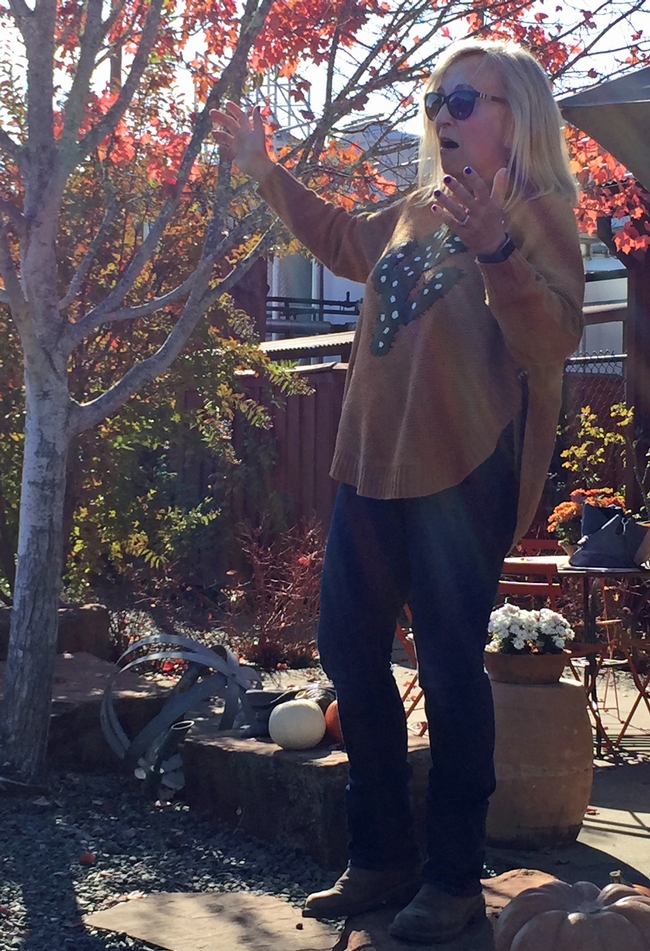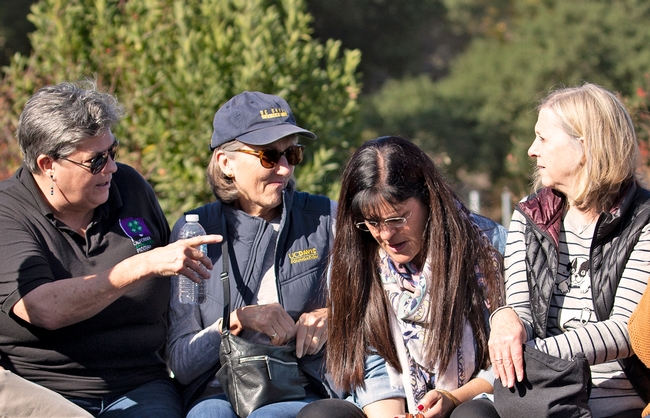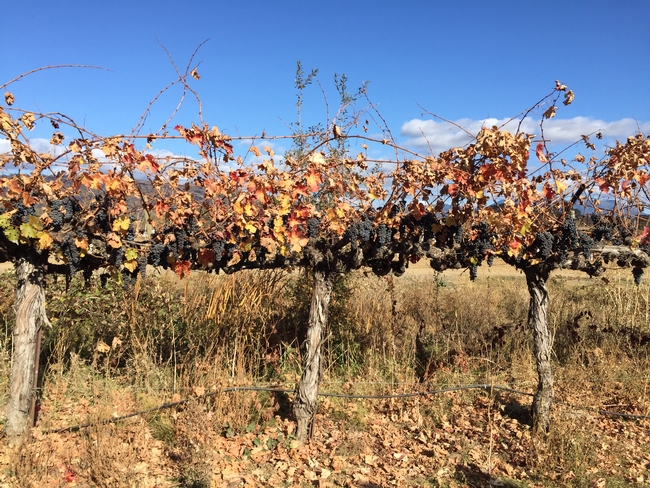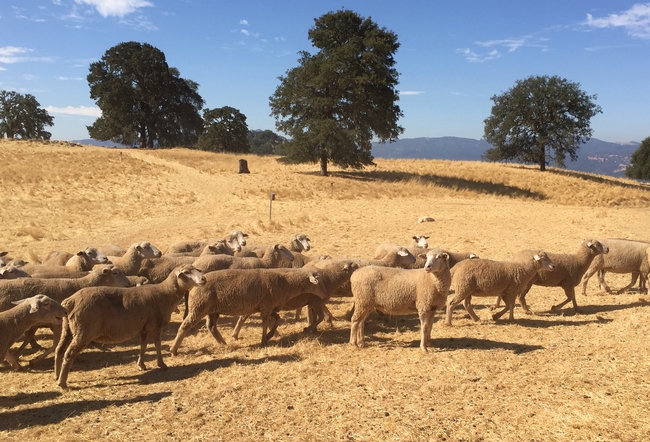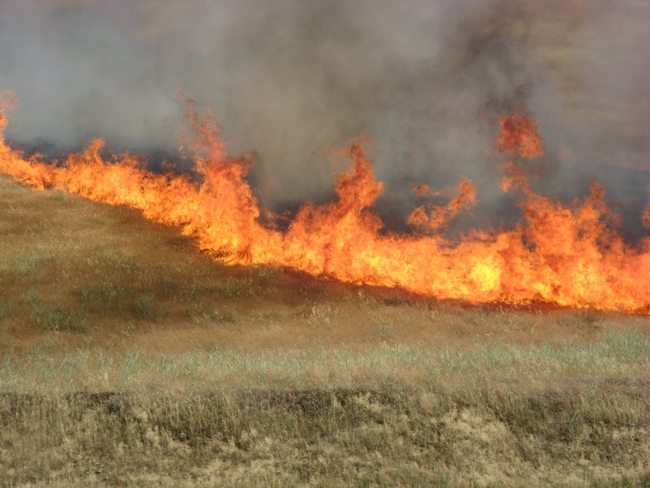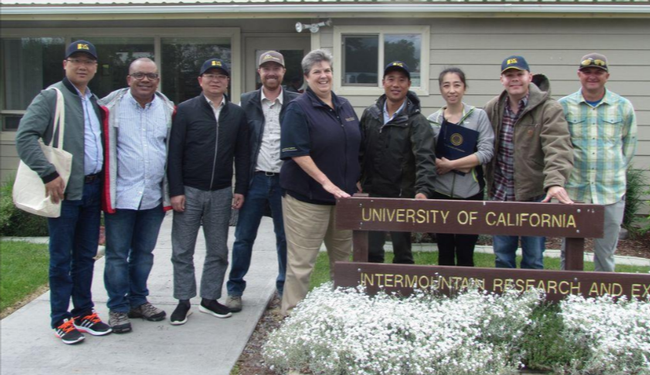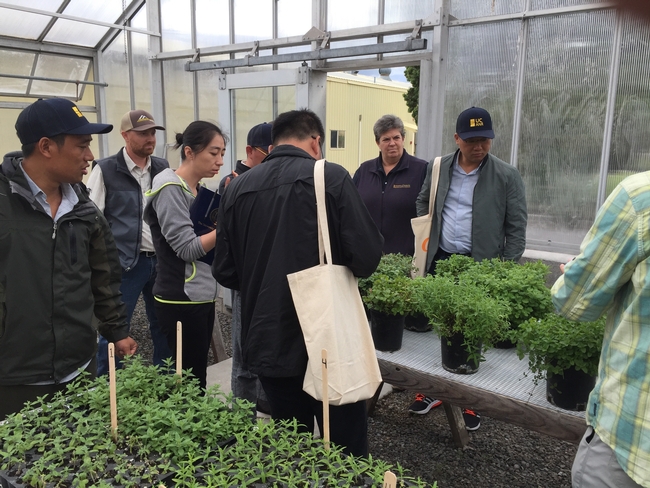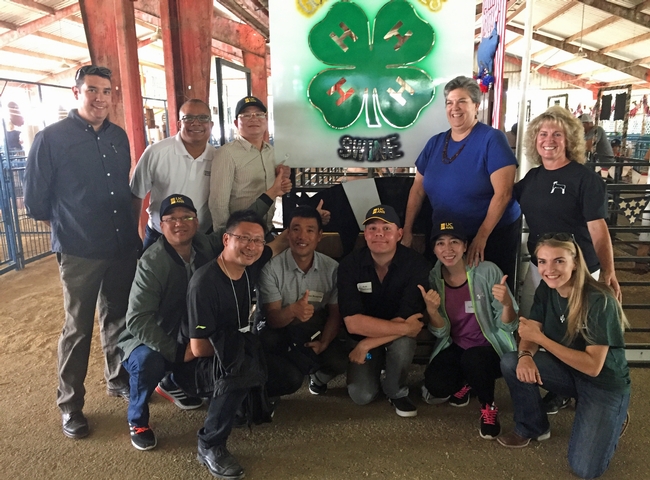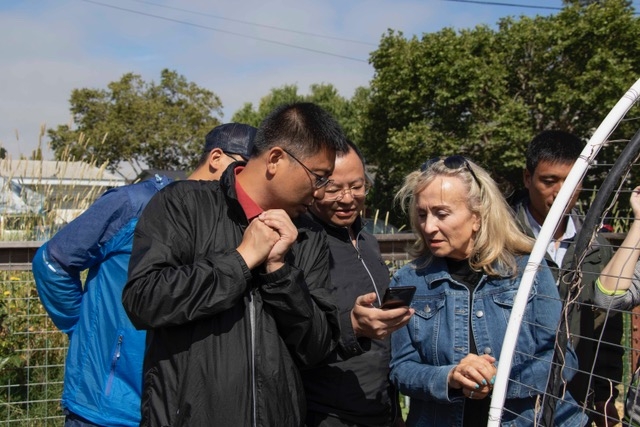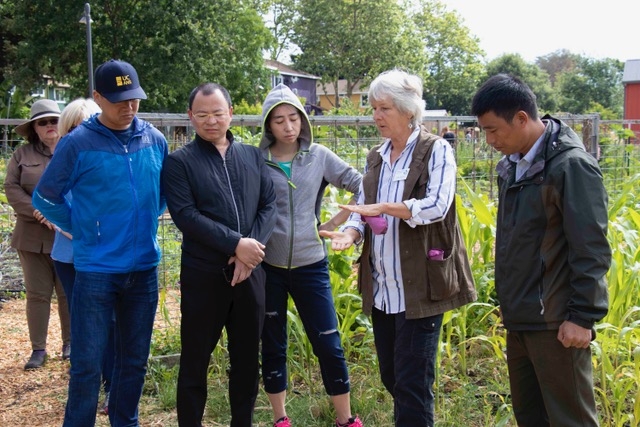Posts Tagged: Stephanie Larson
Celebration Corner
CSAC honors UCCE San Luis Obispo team
A representative of the California State Association of Counties (CSAC) presented the County of San Luis Obispo with the 2023 CSDC Challenge Award during the Board of Supervisors meeting on April 9.
The annual award is presented to California counties to highlight innovative programs developed at the county level.
CSAC CEO Graham Knaus presented the CSAC Challenge Award for the Cross-Sector Partnerships for Food and Nutrition Security program to Jen Miller, County of San Luis Obispo health promotion division manager; Shannon Klisch, County of San Luis Obispo department head and director of UC Cooperative Extension in San Luis Obispo, Santa Barbara, and Ventura counties; and Mishelle Costa, CalFresh Healthy Living, UC community education supervisor.
The team developed partnerships with multiple organizations to ensure that fresh produce is more available in the surrounding community. They collaborated to increase the number of markets that accept CalFresh and offer Market Match, provide a more consistent and welcoming experience for CalFresh customers across markets, and increase the visibility of farmers market nutrition incentives.
Together, they have increased equitable access to healthy food and support for local farmers.
According to the County of San Luis Obispo, 8.4% of all residents and 9.7% of all children countywide are defined as food insecure, or "lacking consistent access to enough food for an active, healthy life."
Battany honored with ASEV Extension Distinction Award
Mark Battany, UCCE water management and biometeorology advisor in San Luis Obispo and Sant Barbara counties, has been selected for the 2024 American Society for Enology and Viticulture Extension's Distinction Award.
The ASEV Extension Distinction Award is given to a current ASEV member and extension educator based on their contributions to enology or viticulture through their extension program, or the translation of novel research findings into commercially applicable tools for enologists or viticulturists.
Battany will present “Flipping dimensions: A vertical weather view helps illuminate vineyard challenges,” at the 75th ASEV National Conference in Portland, Oregon, on June 19.
CalFresh Healthy Living, UCCE Riverside and partners win health equity award
CalFresh Healthy Living, UCCE Riverside, CFHL, UC Davis and the Torres Martinez Desert Cahuilla Indians Community Wellness Committee Partnership are being honored with the first National Cooperative Extension health equity award.
The 2024 National Cooperative Extension Priester Health Equity Award recognizes extraordinary programs and professionals that are modeling next-generation work in the area of health and well-being.
The project includes nutrition, garden and physical activity education with the Torres Martinez community. The overarching goal is to foster greater health and well-being through activities that engage the participants with culturally relevant materials and work to restore traditional food systems.
The team includes Claudia Carlos, CFHL, UCCE Riverside supervisor; the Coachella Valley team of community nutrition educators Esmeralda Nunez, Vianca Nunez and Jackie Velarde; Andra Nicoli, CFHL, UC Davis project policy analyst; and Chutima Ganthavorn, UCCE nutrition, families and consumer sciences advisor emeritus.
UCCE Riverside County farm advisor Philip Waisen, through a Centers for Disease Control and Prevention grant titled ACORNS, pairs lesson activities with farm and nutritional health webinars. UCCE Riverside Master Gardener Brad Hardison offers garden support, resources and education.
Tribal Council Vice Chairman Joseph Mirelez and Community Wellness Committee members anchor health-education initiative activities in local tradition and events for sustained effectiveness.
The award will be presented at the National Health Outreach and Engagement Conference on May 13-15 in Greenville, South Carolina.
Kudos for Rose, Casseer
Kendra Rose, senior contracts and grants officer and Dilshan Casseer, proposal development coordinator, earned gratitude from Whitney Brim-DeForest, UCCE director in Sutter and Yuba counties and rice and wild rice advisor.
“I would like to shout out Kendra Rose and Dilshan Casseer for their incredible help in preparing a grant for submission!” said Brim-DeForest. “They have both gone above and beyond, assisting in editing and writing, helping me and my co-PIs prepare draft documents for submission. Their guidance, preparation and timely meetings have made this process incredibly easy for my colleagues and me. Thank you so much to both of them!”
Larson receives ASI Bradford-Rominger Leadership Award
Stephanie Larson, UC Cooperative Extension director and livestock and range advisor for Sonoma County, is one of two recipients of the Eric Bradford & Charlie Rominger Agricultural Sustainability Leadership Award, which is given by the Agricultural Sustainability Institute at UC Davis. Annie Main, a pioneering farmer at Good Humus in Yolo County, is the other honoree.
Larson has spent more than 40 years working for UC Cooperative Extension to address opportunities and issues that California ranchers face in their agricultural businesses. Her interdisciplinary approach to issues facing livestock producers, rangeland owners and managers, and the public aims to maintain and increase the sustainability of agriculture systems and the environment, with a particular focus on ecosystem services in counties under threat from encroachment by urban development.
“Stephanie is the gold standard of what a UC ANR advisor should be – she has a robust, relevant county program, provides leadership and vision for statewide programs; she offers her service to professional societies and she is highly regarded by all who work with her,” said Theresa Becchetti, UC Cooperative Extension livestock advisor, one of the 20 UCCE peers who nominated Larson for the award.
Larson and Main will receive their awards at a ceremony featuring distinguished speaker Hannah Wittman, interim co-director of the University of British Columbia Centre for Climate Justice, on Wednesday, May 15, 4–7 p.m. To register for the event, visit https://registration.ucdavis.edu/Item/Details/1137.
The Bradford-Rominger award recognizes and honors individuals who exhibit the leadership, work ethic and integrity epitomized by the late Eric Bradford, a livestock geneticist who gave 50 years of service to UC Davis, and the late Charlie Rominger, a fifth-generation Yolo County farmer and land preservationist. The annual award was suspended during the COVID-19 pandemic and these will be the first awards given since 2020.
Match.Graze matches livestock with land to reduce wildfire fuel
UCCE Sonoma County is excited to announce a new tool to match grazers with landowners: Match.Graze. The free online service that allows users to find their perfect grazing match, is now live.
“It's like Tinder for livestock,” said Stephanie Larson, UCCE livestock and range management advisor and director for Sonoma County, who developed Match.Graze.
Match.Graze is an interactive database of California contract grazers and landowners. Property owners create profiles with information about land they have available for grazing while livestock owners enter specifics about their herds for hire. That information will be associated with a marker pinned on a map of California. Users will be able to search the markers to find a contract grazer or available acreage to suit their vegetation management needs.
“Every property is different and requires thoughtful consideration of how it should best be grazed,” Larson said. “Put Match.Graze to work and let's prevent catastrophic fire while helping landowners and livestock owners.”
Larson would like your help getting the word out to livestock owners and landowners across the state who may want to participate.
To get started, they should go to https://matchgraze.com and create a pin.
“We recommend doing this on a computer rather than a phone,” said Karen Giovannini, UCCE agriculture ombudsman for Sonoma County.
To make it easy for you to share Match.Graze with your landowners and grazers, Giovannini has assembled a sample email message, videos that explain the program, sample social media posts, photos of grazing animals and more at http://ucanr.edu/MGpromo.
Regent Stegura 'blown away' by UCCE Sonoma work
Vice President Glenda Humiston introduced alumni regent-designate Debby Stegura to UC Cooperative Extension staff and their community partners and clientele in Sonoma County on Nov. 15.
After visiting Beretta Dairy, Bayer Farm Park and Gardens, Sheppard Elementary and Stuhlmuller Vineyards, Regent Stegura tweeted:
“Blown away by @ucanr tour of @UCCESonoma work—Beretta dairy, @UCMasterGarden, @Stuhlmullerwine, @California4H. Saw #kincaidfire reach, how to prepare better for future fires. @ucanr work benefits all of CA. Thank you!”
The retired business litigator and UC Davis alumna was joined on the tour by Anne Shaw, secretary and chief of staff to the regents, and Michael Bedard, UC state government relations legislative director.
Stephanie Larson, UCCE director for Sonoma County, led the tour, which first visited Beretta Dairy.
“It's so nice to have a dairy advisor,” Sonoma County dairy farmer Doug Beretta said, crediting Randi Black, UC Cooperative Extension dairy advisor, with providing the technical assistance he needed to apply for a grant to reduce methane emissions.
Black, who joined UC ANR in 2017, helped four local dairies obtain grants totaling $2.5 million and said the projects propose to reduce emissions by 9,327 metric tons of CO2 equivalent over the next 5 years, which is comparable to removing 2,028 passenger vehicles from the road for a year.
Beretta talked about the work he has done at the dairy, based on UC research, to improve water quality. David Lewis, UCCE director for Marin and Napa counties, noted that similar manure management and water-quality work is being implemented by UCCE clientele in his counties.
Discussing the hardships created by low milk prices in the dairy industry, Beretta said he appreciated UCCE's agricultural ombudsman Karen Giovannini guiding producers who want to sell value-added products through the permitting process.
From the dairy, Stegura and the group met with Mimi Enright, UC Master Gardener Program manager for Sonoma County, UC Master Gardener volunteers and Julia Van Soelen Kim, North Bay food systems advisor at Bayer Farm Park and Gardens.
Collaborating with Bayer Farm, the Master Gardeners have been expanding outreach to Spanish-speaking members of the community. In addition to all of the traditional Master Gardener outreach, the Master Gardeners in Sonoma County have been actively promoting firewise landscaping to help Sonoma County residents better prepare for wildfires. Using UC ANR materials is critical, Enright said, to assure people the recommendations are based on scientific research.
After the Kincade Fire, when growers and gardeners asked if produce grown outdoors was safe to eat, Enright said UCCE Sonoma County could tell them, based on local research, it was safe to eat if consumers removed outer leaves and washed the produce and that the health benefits of eating fresh produce outweigh any trace contamination.
UCCE has been leading a coalition of community partners and government organizations to educate the community on reducing food waste and increasing food recovery. When PG&E announces public safety power shutoffs, they promote composting food that can't be eaten so it doesn't end up in a landfill.
“This kind of service in communities is not as well-known about UC as the campuses,” Humiston commented to the regent.
Across the street from Bayer Farm, Diego Mariscal, 4-H program assistant, has been collaborating with Sheppard Elementary School. It is one of several schools in the county providing 4-H afterschool clubs and other 4-H programs designed to nurture the next generation of Latino leaders. Last spring, Mariscal worked with families to build a 4-H soccer league for elementary school children. Parents, college and high school students were trained by 4-H to teach children teamwork, soccer skills and healthy eating habits. More than 200 new underserved youth participated in 4-H programs in Sonoma County during the 2018-2019 year.
A few of the soccer players, proudly wearing their green 4-H soccer uniforms, told the group what they liked about 4-H. 4-H All Star Corrianna E., who participates in the 4-H teen program, shared her experience in 4-H and expressed gratitude to the program for helping her overcome her shyness to become a strong public speaker. Corrianna's mother, Naomi Edwards, also shared her experience as 4-H Council President for Sonoma County.
The tour's last stop was at Stuhlmuller Vineyards, where vineyard manager John Gorman told Stegura and the group that California's preeminent grape growing region relies on UCCE for sound advice to manage pests and emerging problems.
“You want to know what's a good cultural practice? Rhonda Smith has answers backed up by hard science,” Gorman said of the UCCE viticulture advisor.
Larson introduced new UC IPM advisor Cindy Kron, who succeeds recent retiree Lucia Varela. Kron is launching an IR-4 project to study pesticides for olives, which isn't a big enough market to interest private investment in research. She's also monitoring pears for brown marmorated stink bug because early detection is key to controlling the pest. Spotted lanternfly isn't in California yet, but grapes are among its favorite hosts so Kron is working with UC Master Gardener volunteers and other community members to watch for the exotic pest.
The Kincade Fire destroyed fences and scorched the rangeland at Stuhlmuller Vineyards, forcing Gorman to sell the cattle. He showed the group where the fire failed to advance at the fire break created by the lush vineyards. As a result of the Kincade Fire, Gorman wasn't able to sell his petite verdot, chardonnay and cabernet grapes to wineries. To prove to the insurance company that smoke damaged the crop, his crew picked 30 tons of grapes for testing.
During and after the devastating fires in the North Bay, Larson, who is also a UCCE livestock and range management advisor, assisted livestock owners to gain access to their burned properties; this ensured their animals got food and water. She also organized resource meetings for landowners affected by fires, helping them apply for funding from government agencies and insurance companies for animal, forage and facility losses.
Larson also said her new grazing database Match.Graze has been well-received by ranchers and landowners in Sonoma and Marin counties who want to use grazing to reduce fire fuels. Land managers and grazers can sign up at ucanr.edu/matchgraze to hire sheep, goats, cattle and horses to manage fire fuels.
The regent tours in Sonoma Country and Fresno County were coordinated by Anne Megaro, government and community relations director. She is planning future tours for regents at UC South Coast Research and Extension Center and other locations in the spring.
Livestock and poultry owners asked to take survey on fire impact
People raising cattle, sheep, goats, poultry, swine, horses, llamas, alpacas, aquaculture species or other production-oriented animals in California who have experienced at least one wildfire on their property within the last 10 years are being asked to participate in a Fire Impact and Risk Evaluation (FIRE) survey.
“We will aim to quantify the impact of wildfires in different livestock production systems,” said Beatriz Martinez Lopez, director of the Center for Animal Disease Modeling and Surveillance in the UC Davis School of Veterinary Medicine. “The idea is also to create a risk map showing areas more likely to experience wildfires with high economic impact in California.
“This economic and risk assessment, to the best of our knowledge, has not been done and we hope to identify potential actions that ranchers can take to reduce or mitigate their losses if their property is hit by wildfire.”
Martínez López, who is also an associate professor in the Department of Medicine & Epidemiology at UC Davis, is teaming up with UC Cooperative Extension livestock and natural resources advisors and wildfire specialists around the state to conduct the study.
The research team includes
- Matthew Shapero, UC Cooperative Extension advisor in Ventura County
- Rebecca Ozeran, UCCE advisor in Fresno and Madera counties
- Stephanie Larson, UCCE livestock range management advisor in Sonoma and Marin counties
- Sheila Barry, UCCE livestock and natural resourcesadvisor, in Santa Clara, San Mateo, San Francisco, Alameda and Contra Costa counties
- Josh Davy, UCCE livestock, range and natural resources advisor in Tehama, Colusa and Glenn counties
- Max Moritz, UCCE wildfire specialist, UC Santa Barbara
- Luke Macaulay, UCCE rangeland planning and policy specialist at UC Berkeley
- Lenya Quinn-Davidson, UCCE wildfire advisor in Humboldt, Siskiyou, Trinity and Mendocino
- counties
“The idea came up in a conference in San Diego, just when we had several ongoing wildfires and we were discussing how poorly are some areas prepared for this and the need for better emergency planning, coordination and response when not only people, but also large animals are involved,” Martínez López said. “We hope this study will provide the foundation to advance in this direction.”
“Right now, we have no good estimate of the real cost of wildfire to livestock producers in California,” said Rebecca Ozeran, UC Cooperative Extension livestock and natural resources advisor for Fresno and Madera counties. “Existing UCCE forage loss worksheets cannot account for the many other ways that wildfire affects livestock farms and ranches. As such, we need producers' input to help us calculate the range of immediate and long-term costs of wildfire.”
Stephanie Larson, UC Cooperative Extension livestock and range management advisor for Sonoma and Marin counties, agreed, saying, “The more producers who participate, the more accurate and useful our results will be.”
“We hope the survey results will be used by producers across the state to prepare for wildfire,” said Matthew Shapero, UC Cooperative Extension livestock and natural resources advisor for Ventura and Santa Barbara counties, “And by federal and private agencies to better allocate funds for postfire programs available to livestock producers.”
The survey is online at http://bit.ly/FIREsurvey. It takes 15 to 30 minutes, depending on the number of properties the participant has that have been affected by wildfire.
“Survey answers are completely confidential and the results will be released only as summaries in which no individual's answers can be identified,” said Martínez López. “This survey will provide critical information to create the foundation for future fire economic assessments and management decisions.”
The team would like your help in encouraging livestock producers who have experienced wildfire to participate in the FIRE survey.
Chinese scientists tour California agriculture with UC ANR
To promote the exchange and sharing of agricultural extension information, several U.S. Land Grant institutions have formed an alliance with 10 Chinese agricultural universities. From June 17 to 22, UC ANR took a group of scientists from Chinese agricultural universities on a tour of agriculture in Northern California.
“The Chinese face many of the same issues that we do here in the U.S.,” said VP Glenda Humiston. “The Chinese universities want to improve rural economic development to lift up the quality of life for people in rural communities. They are also responding to global climate change, drought and pests while trying to improve food security and water use efficiency. They see UC Cooperative Extension as an effective research model; we hope that scientific collaborations will accelerate solutions and help maintain relations for California agriculture with China.”
The Chinese Extension Alliance Delegation included Song Hui, vice dean of the New Rural Development Research Institute of Northeast Agricultural University; Sun Wenpeng, professional extension personnel of Northeast Agricultural University; Luo Jian, associate professor of business at Hunan Agricultural University; He Minghui, associate professor of business at Hunan Agricultural University; and Li Peng, director of the Office of Invigorating Agriculture with Science and Education in the Department of Science and Technology.
The group toured Oregon agriculture with Oregon State University representatives, then drove from Klamath Falls with Humiston and Greg Gibbs and Rob Broadhurst of Development Services to begin the California tour at UC ANR's Intermountain Research and Extension Center in Tulelake. Rob Wilson, Intermountain REC director, showed them research being conducted on potatoes and mint breeding. From there, the group headed out to tour Shasta Dam.
In Redding, Larry Forero, UCCE director in Shasta County, and Rick Satomi, UCCE forest advisor, told the Chinese delegates about local research and outreach, then introduced them to 4-H youth and families at the Shasta District Fair, where 4-H members were bringing livestock for show.
UCCE advisors Josh Davy and Allan Fulton discussed orchards and water in Tehama County.
In Yuba City, UCCE director Janine Hasey and her staff gave the guests an overview of UCCE programs in Yuba and Sutter counties and plans for celebrating the office's 100th anniversary on Aug. 24. They met with UCCE pomology advisors, who gave them a tour of Sierra Gold Nurseries orchards and walnut rootstock research sites and discussed collaborations with growers.
Stephanie Larson, UCCE director in Sonoma County, drove the group around areas in Santa Rosa that burned in October and discussed UCCE's fire research and outreach to the community. The group also met with UCCE staff in Sonoma County to discuss food access, 4-H youth development, natural resources and wine grapes.
For a view of UC Cooperative Extension from the campus perspective, Mark Bell, vice provost of Strategic Initiatives and Statewide Programs, introduced the group to colleagues in the College of Agricultural & Environmental Sciences at UC Davis. They met with Mimi Rose, program coordinator for international programs; Martin Smith, UCCE specialist in the Department of Human Ecology; Ron Tjeerdema, associate dean for Environmental Sciences; Bruce Linquist, UCCE rice specialist; Jim Hill, emeritus UCCE specialist; and Louise Ferguson, UCCE specialist and founder of the Fruit and Nut Research and Information Center.
Anne Megaro, director of governmental and community relations, introduced the group to Gail Feenstra, deputy director and food systems coordinator of UC ANR's Sustainable Agriculture Research and Education Program, and Sonja Brodt, academic coordinator. Then they toured the Russell Ranch Sustainable Agriculture Facility with soil science post-doc Daoyuan Wang and the UC Davis Student Farm with its director Katharina Ullmann.
“They have extension in China, but it is not like ours,” said Megaro. “They are looking to strengthen their advisor positions and develop a mechanism for career advancement, similar to what we have in the U.S.”
The Chinese Extension Alliance Delegation wrapped up their tour at UC ANR's offices in Davis to learn about UC ANR's statewide programs. Jim Farrar discussed the Statewide Integrated Pest Management Program, Missy Gable described the Master Gardener Program, Shannon Horrillo talked about the 4-H youth development program, Greg Ira explained California Naturalist; and Katie Panarella covered the Nutrition, Family and Consumer Sciences, Expanded Food Nutrition Education (EFNEP) and Master Food Preserver programs.
Humiston, who met with the China-US University-based Agricultural Extension Alliance in China in March of 2017, said, “We look forward to collaborating with our agricultural extension colleagues in China.”
See more photos of the tour at https://www.flickr.com/gp/151501801@N07/YVBqk6.

